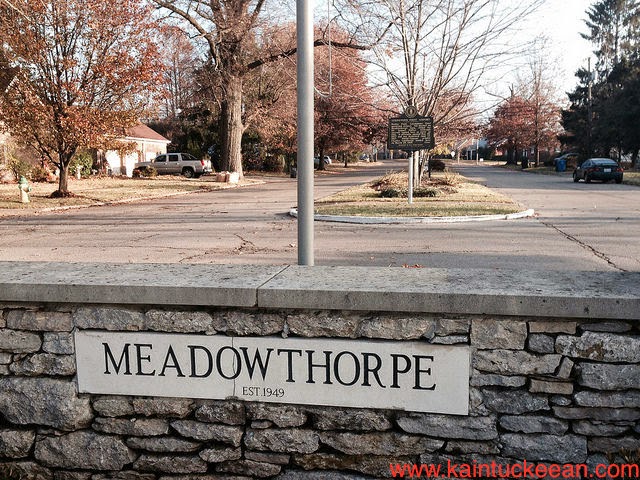 |
| The entrance to the Meadowthorpe neighborhood. Author's collection. |
Last month, a historic marker was dedicated at the Lexington intersection of Leestown Road at Boiling Springs Drive. The spot marks the entrance to Lexington's first true subdivision: Meadowthorpe.
In a chapter on the Bluegrass region in
Lost Lexington, I mentioned the Meadowthorpe neighborhood and the historic airport. From
Lost Lexington:
In the early 1950s, Lexington’s first true subdivision was developed off Leestown Road. The subdivision was named Meadowthorpe, after the large residence associated with the equine stock–farm that once operated there. The area was also once the site of Lexington’s first municipal airport, Halley’s Field. It was here that Charles Lindbergh secretly arrived to visit his friend in 1928. Despite an attempt at secrecy for Lindbergh’s visit, word spread of the famous aviator’s arrival and three thousand witnessed the challenging takeoff from the open field that was bounded by both tree and telephone wires. Subdivision of the farm and the erection of houses at Meadowthorpe began in late 1949, with the subdivision’s first homes being constructed from the limestone fences that once dotted the farm’s landscape. At the time, living in Meadowthorpe was still considered “rural living.”
 |
| Historic marker of "Lexington's First Airport" at Meadowthorpe. Author's collection. |
The historic marker, #2440, offers this history:
Halley Field, Lexington’s first municipal airport, was located on Meadowthorpe Farm, owned by Dr. Samuel Halley. Although aircraft landed here as early as 1921, it officially opened May 28, 1927 and was dedicated June 10, 1927. World-famous aviator Charles Lindbergh landed here on March 28, 1928. Over.
(Reverse) Halley Field hosted air circuses, air shows, flight training, sight-seeing tours and small airlines. It reverted back to farmland in 1934 and became a subdivision in 1949. Meadowthorpe Farm included a two-story Greek Revival house, later purchased and enlarged by Col. James E. Pepper, distiller and owner/breeder of Thoroughbreds.
 | This post includes an excerpt from Lost Lexington, Kentucky.
Lexington has dozens of well-restored landmarks, but so many more are lost forever. The famous Phoenix Hotel, long a stop for weary travelers and politicians alike, has risen from its own ashes numerous times over the past centuries. The works of renowned architect John McMurtry were once numerous around town, but some of the finest examples are gone. The Centrepointe block has been made and unmade so many times that its original tenants are unknown to natives now.
|
|
Click here for details on author events and purchase info! |



Comments